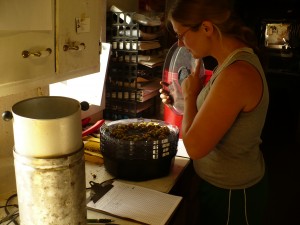In the Northeast, hop harvest generally begins in mid-August and continues through mid-September. Harvest date is primarily dependent on the hop variety. However weather can delay or hasten when a harvest will occur. Another factor that can influence harvest date is pest issues, including heavy spider mite and downy mildew infestations. In the major hop growing regions, harvest is generally targeted when cones reach approximately 23% dry matter.

To determine your hops target dry matter, randomly sample 5 to 10 sidearms of the same variety from throughout the hopyard. Samples should be taken from near the top of the trellis, approximately two feet below the trellis wire. The sample should reflect the state of your yard, and should be taken when there isn’t excess moisture in the hopyard, i.e. after the morning dew has dried, when it isn’t raining, etc. Pick the cones off of the sidearm into a bucket, and mix thoroughly before selecting a subsample of 100 to 150 cones.
Once you have your subsample you can begin the determination of dry matter. Weigh an empty container in grams. Weigh the freshly picked hops in the container, and record both weights. Dry the hops down to 0% moisture. This can be done one of several ways:
1.) Overnight in a food dehydrator at 140 – 150°F
2.) In a Koster Moisture Tester (commonly used to test forage moisture)
3.) In a microwave or oven, being sure to remove the sample every minute or less to prevent scorching.
Using a food dehydrator will allow the cones to dry to 0% moisture overnight. However, the Koster tester and microwave methods require constant monitoring as they will dry the cones relatively quickly. Once the sample has reached a stable weight, the hops are at 0% moisture. Weigh the dry hops and record the weight in grams. To calculate the percent dry matter, use the following equation:
Expected maturities for select varieties can be found in the Yakima Chief, Inc. Hop Variety Guide.
Harvesting too early can reduce the yield of your hopyard and can also have an effect on next year’s yield. This is especially true for new hopyards, early maturing varieties, or varieties with low vigor, as it disrupts the carbohydrate partitioning into the root system. Harvesting too early will also disrupt the flavor constituents of your hops as the alpha acids might not have reached peak levels. However, harvesting too late can also reduce brewing quality and aroma. Later harvested hops are at risk of accelerated oxidation in storage through the loss of volatile aroma compounds. Later harvested hops usually suffer from a shortened storageability, as do cones that have been damaged by diseases and/or pests. Be aware that cones that have been damaged by spider mites and other pests are prone to over-drying.
Hops should be dried down to 8-10% moisture (or 90 – 92% dry matter) for packaging and storage. Cones above this moisture will quickly loose quality due to microbial degradation, and cones below this moisture will fall apart and lose quality due to oxidation. To learn how to determine cone moisture during drying, and for further information about hop harvest determination, please click here.
You can also check out our YouTube video on Determining Hop Harvest Moisture and Ideal Storage Dry Matter.
To make things even easier, UVM Extension has come up with a Hops Harvest Moisture Calculator! Click here for the online tool.
Don’t have internet access in your hopyard? Download the Excel version of the Hops Harvest Moisture Calculator here!
